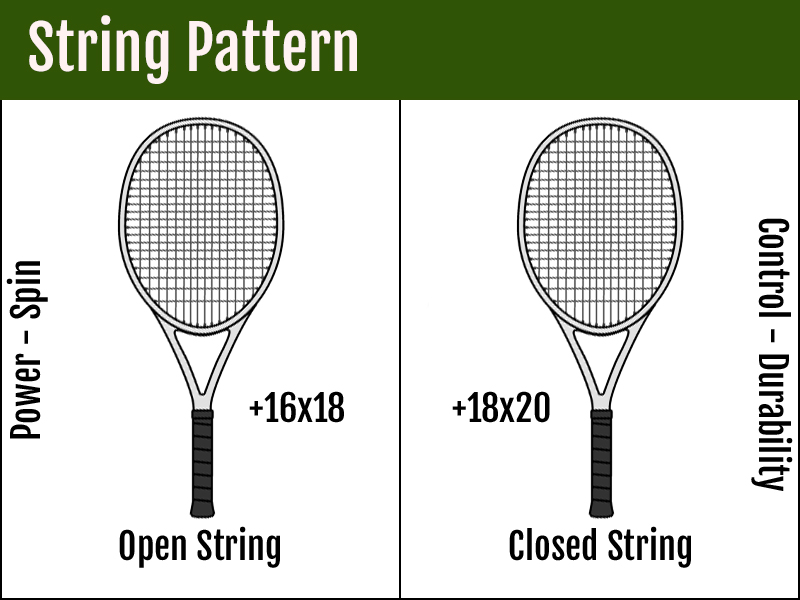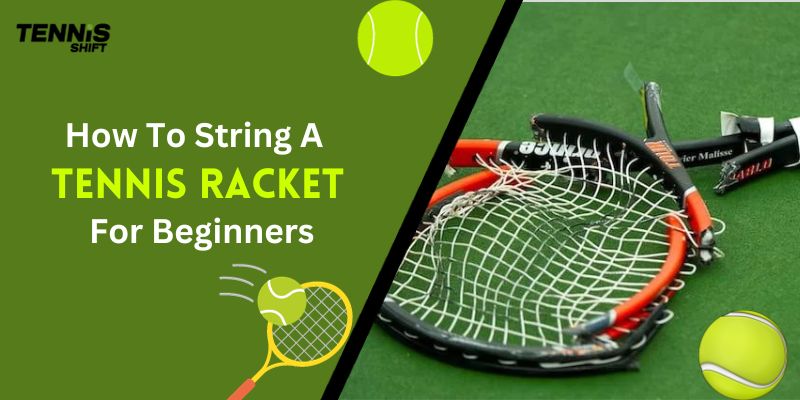If you play tennis very often and you are a beginner tennis player eager to learn how to string a tennis racket for beginners on your own? Stringing a tennis racket may seem like an intimidating task, but with the right guidance and a little practice, you’ll be able to master it in no time.
To install string in a tennis racket for beginners, you’ll need the right tools and follow a step-by-step tutorial or seek professional assistance for best results.
In this step-by-step guide, we’ll walk you through the process of tennis string installation from start to finish. So grab your tools and let’s dive into the world of restrung tennis!
How To String A Tennis Racket For Beginners – Step By Step Guide
Tennis racquet stringing may seem daunting, but with the right guidance, beginners can learn to do it themselves. Here’s a detailed guide to help you get started.
What You’ll Need
Before you begin, gather these essential tools and materials:
- Racket stringer machine or manual stringing tool
- Tennis strings pattern suitable for your playing style
- Scissors or string cutters
- Awl or starting clamp
Removing Old Strings
Use the awl or starting clamp to carefully remove the old strings from your racket. Make sure the frame is clean and ready for the new strings.
Stringing the Main Strings
Choose two main strings that will create an “X” pattern. Insert one end of each string into adjacent holes at the bottom of the racket head.
Use your chosen method to apply tension evenly to both main strings, following manufacturer guidelines for your racket’s recommended tension.
Weaving the Cross Strings
Begin weaving cross strings above the main strings, alternating the pattern as you go. Avoid pulling too tightly to prevent distortion of the racket head shape.
Repeat the weaving process until all cross strings have been threaded across the mains.
Finishing Touches
Securely tie off each end of the strings with an appropriate knot, such as a double half-hitch or finishing knot.
Trim any excess string length using scissors or cutters.
Final Tips
Remember to:
- Take note of common beginner mistakes to avoid them in future restringings.
- Stay tuned for more tips on maintaining and caring for your newly strung racket.
With these step-by-step instructions, you can successfully string your tennis racket and enhance your game!

Tools and Materials Needed
To successfully string a tennis racquet, you’ll need a few essential tools and materials. Here’s a list of what you’ll need to get started:
1. Tennis String: This is the main component of the stringing process. It’s important to choose a high-quality string that suits your playing style and preferences.
2. Tennis Racket: Obviously, you’ll need the racket itself! Make sure it’s in good condition before beginning the stringing process.
3. Stringing Machine: A stringing machine is necessary for accurately tensioning and securing the strings on your racket. There are different types available, ranging from manual to electronic machines.
4. String Cutter: You’ll need a reliable string cutter to trim excess strings once they’re installed on your racket.
5. Awl or Starting Clamp: An awl or starting clamp helps in pulling the main strings through the grommets at the top of the frame during installation.
6. Pliers: Pliers are useful for tightening knots and adjusting tension during string installation.
7. Gripper or Floating Clamps: These clamps hold down one end of each main (vertical) while weaving crosses (horizontal).
8. Tension Calibrator or Electronic Tension Meter(optional): A tension calibrator ensures that your machine is calibrated correctly so that accurate tensions can be achieved consistently throughout all rackets strung with it.
Now that you have an idea about what tools and materials are needed let’s move on to how to actually go about stringing your tennis racket as a beginner! Stay tuned!
Tips for Beginners to String a Tennis Racquet
When it comes to stringing a tennis racquet for the first time, beginners may feel overwhelmed and unsure of where to start. But fear not! With the right guidance and a little practice, you’ll be able to string your racket like a pro in no time. Here are some helpful tips to get you started on your stringing journey.
1. Choose the Right String Tension: As a beginner, it’s recommended to start with a lower string tension. This will provide more power and forgiveness on your shots, making it easier to control the ball.
2. Use Proper Technique: Stringing a racket requires precision and attention to detail. Make sure you follow the manufacturer’s instructions carefully and take your time during each step. A well-strung racket can greatly enhance your performance on the court.
3. Invest in Quality Tools: Having the right tools is crucial for successful stringing. Purchase a good quality stringing machine that suits your needs and budget, along with other necessary tools such as pliers, awl, scissors, and starting clamp.
4. Seek Guidance from Experienced Players or Professionals: If you’re feeling uncertain about any aspect of stringing, don’t hesitate to ask for help from experienced players or professionals at local tennis shops or clubs.
5. Practice Makes Perfect: Like any skill, practice is key when it comes to mastering racket stringing techniques. Start by practicing on old rackets before moving on to restringing your primary one.
By following these tips and gaining experience through practice, you’ll become more confident in handling all aspects of racket stringing as a beginner player.
Common Mistakes to Avoid
Stringing a tennis racquet may seem like a daunting task, especially for beginners. However, with the right knowledge and practice, you can become proficient in this essential skill. To help you on your stringing journey, here are some common mistakes to avoid:
1. Incorrect tension: One of the biggest mistakes beginners make is not using the correct tension when stringing their racket. It’s important to follow the manufacturer’s recommendations or consult with an experienced stringer to ensure optimal performance.
2. Uneven string bed: Another common mistake is creating an uneven string bed. This can lead to inconsistent ball response and decreased playability. Take your time when weaving the strings and use a starting clamp to maintain even tension throughout.
3. Over-tightening knots: Tightening knots too much can cause damage to both the strings and grommets. Be sure to tighten them just enough so they are secure but not overly tight.
4. Neglecting proper maintenance: Once you’ve successfully strung your racket, it’s crucial to take care of it properly. Avoid excessive exposure to extreme temperatures or moisture as these factors can weaken the strings over time.
By avoiding these common mistakes, you’ll be on your way to effectively stringing your tennis racket like a pro! With practice and patience, you will soon feel confident in maintaining your equipment for optimal performance on the court.
Maintaining Your Strung Racket
Maintaining your strung tennis racket is crucial to ensure its durability and peak performance during matches. Here are some valuable tips to help you keep your racket in optimal condition:
Regular String Inspection
Frequently examine the strings for any signs of wear or damage. Look out for fraying, loose strings, or noticeable drops in string tension. If you detect any problems, it’s wise to schedule a restringing session promptly.
Post-Game Cleaning
After each game, take a moment to wipe down your racket with a damp cloth. This simple practice removes dirt and sweat that can accumulate during play. Preventing the buildup of grime is essential to maintaining the feel and playability of the strings.
Avoid Extreme Conditions
Protect your racket from extreme temperatures and prolonged exposure to direct sunlight. High heat can lead to quicker loss of string tension, while excessive cold makes strings brittle and prone to breakage. Store your racket in moderate conditions to prolong its lifespan.
Invest in a Protective Case
When your racket is not in use, store it in a protective case. This safeguards it against accidental impacts, scratches, or any potential harm that might affect its performance.
Professional Maintenance Checks
Consider scheduling regular maintenance checks with a professional stringer. They can assess the condition of your strings and provide necessary adjustments or replacements as required, ensuring consistent and reliable play.
By following these straightforward maintenance practices, you’ll enjoy a consistent performance from your well-maintained strung racket, enhancing your tennis experience on the court.
Conclusion
To sum it up, beginners can learn to string a tennis racquet with the right guidance and practice. Gather your tools, follow the steps carefully, and don’t forget about maintenance. It’s a valuable skill to have for customizing your racket and ensuring peak performance. Give it a try and enjoy your time on the court!
FAQs
Can you restring a tennis racquet yourself?
Yes, you can restring a tennis racket yourself with the right tools and knowledge.
What tennis racquet string for beginners?
For beginners, multifilament strings or synthetic gut strings are a good choice due to their comfort and playability.
How do I know what tension to string my racquet?
The ideal tension depends on your playing style. Consult with a coach or try a range of tensions to find what suits you best.
Does lower tension mean more power?
Yes, lower tension generally results in more power and a softer feel.
Does higher string tension mean more power?
No, higher string tension typically provides more control but sacrifices some power.
Which is the best mounting system?
The best mounting system depends on the specific application or equipment. Different industries and scenarios have varying requirements, making it crucial to choose a system that aligns with the intended use and preferences.
Why did you switch from the natural gut, too expensive/ not durable enough?
Switched due to cost and durability concerns with natural gut.
Can you use different strings on a tennis racket?
Yes, you can use different strings on a tennis racket based on your playing style and preferences.
